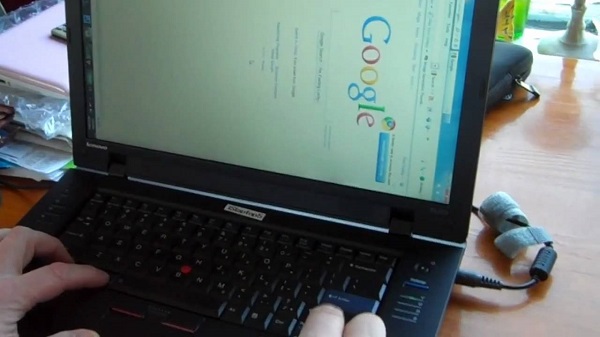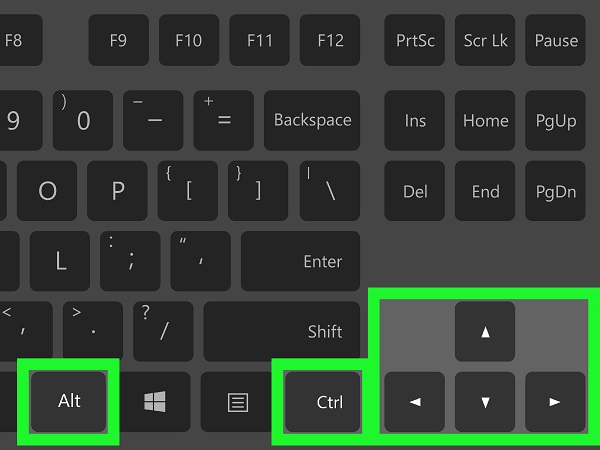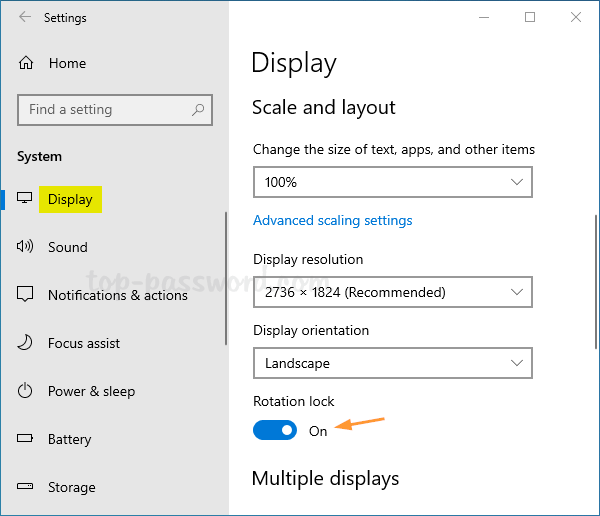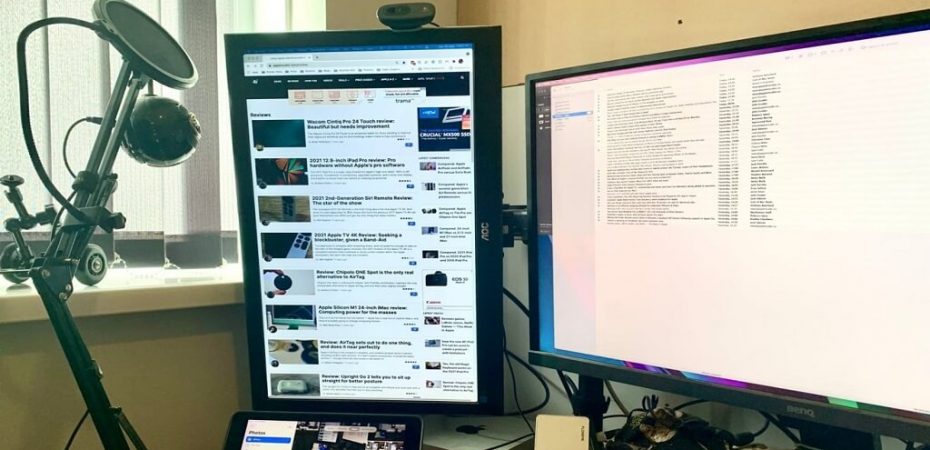Ever wondered if you can switch your computer screen to portrait mode? Turning on full screen can allow you to get the best out of your photos, videos, and sometimes even your Facebook and Twitter feeds. Sometimes your work requires you to turn on the vertical computer monitor screen. So, is it possible?
Typically, your laptop or PC screen orientation will be set to horizontal mode by default. Windows 10, for the most part, works on horizontal screen settings; however, there are situations when the screen automatically switches to vertical.
Your Windows 10 computer does not require other software to rotate the screen settings to a different orientation. This feature is beneficial for computers with rotating monitors. Your PC might already feature a hotkey on the keyboard that allows you to switch to different orientations easily. Sometimes, you accidentally cause the screen to go to a different orientation, and you don’t know how to return.
So, how do I get my screen back to normal size on Windows 10? Here’s how you can flip the computer screen vertical horizontal on your Windows 10 laptop or PC.
Rotating Or Flipping The Screen Orientation On A Windows 10 Computer

The method of rotating the screen’s orientation on a Windows 10 computer is simple and easy. Go to the Windows search tool, write “rotate screen,” press the Open button, and click on the Display Orientation menu. Here’s a more detailed guide:
- Find and click on the Search icon, which is the magnifying glass located in the bottom-left corner of the screen.
- Write “rotate screen” in the search tool and then click Open.
- Open the drop-down menu under the Display Orientation and select your preferred option. You will find this setting in the Scale and layout section.
Note: For systems with multiple monitors, make sure to select the correct monitor from the Display menu first before switching orientations. - The Display Orientation menu will have the following options:
- Landscape: This is the default orientation. Choose this to rotate your screen to full-screen mode.
- Portrait: This mode will switch your screen orientation to vertical, rotating 270 degrees.
- Landscape (flipped): This mode will flip the screen upside-down 180 degrees.
- Portrait (flipped): This mode will rotate your screen orientation to vertical and upside-down, which is 90 degrees.
- To quickly switch back to your original screen orientation, press the Esc key on the keyboard.
Rotating Screen Through Keyboard Shortcuts

Another easy and quick way of rotating the orientation of your screen on your Windows 10 computer is with keyboard shortcuts. Press the keys Ctrl + Alt + right or left arrow keys simultaneously to switch between landscape and portrait mode. To flip the screen upside-down or right side up, press down Ctrl + Alt + up/down arrow keys together.
- For horizontal orientation, press the Ctrl + Alt + Up arrow keys at the same time; this will rotate the screen to the default setting of Windows 10.
- To flip the screen upside-down, which is 180 degrees, press Ctrl + Alt + Down arrow key simultaneously.
- To change your screen orientation to 270 degrees from the default, simultaneously press the Ctrl + Alt + Left arrow key.
- To rotate the screen 90 degrees, press the Ctrl + Alt + Right arrow key simultaneously.
Rotate The Screen Orientation Through The Intel HD Graphic Control Panel
One of the methods of rotating the screen orientation on your Windows 10 PC is through the Intel graphic card’s control panel, which is commonly found on Windows systems.
You can access the graphic card control panel through a clickable icon on the system tray. If you are unable to locate it, you can open the control panel by right-clicking on the desktop and selecting Graphics Properties from the context menu, which will take you directly to the Intel Graphic Card Control Panel.
Once you are there, you will see a range of options that will allow you to adjust the display characteristics, including the screen orientation. You will find the settings for screen rotation within the Display’ or Desktop” option.
Find the rotation setting from the menu, where you can select to rotate the screen to 90, 180, and 270 degrees. There is also a 0-degree rotation option which will take you back to the default orientation.
How to rotate a display Using the NVIDIA Control panel
NVIDIA graphics card users can easily change the screen orientation vertical and horizontal from the NVIDIA Control Panel. Follow these steps:
- Go to your computer’s desktop screen and right-click on an empty space.
- Find and select NVIDIA Control Panel from the menu.
- Find the Rotate Display option on the left side of the window and click it.
- Find the Choose the orientation on the right side of the window and place the for on Landscape.
We have explained how to change screen orientation using Intel and NVIDIA Control Panel. Other graphics cards might have slightly different controls; however, there will be some similarities, so you will not have any issues rotating your display. If you face any problems, share them with Reviewsed.com in the comments section.
How to Turn Off Auto Screen Rotation on Windows 10

Convertible PCs and tablets running on Windows 10 come with an automatic rotate display feature that changes display orientation as the device orientation changes. The Automatic Screen Rotation features on laptops and tabs function similar to iPhones and Android smartphones. Similar to smartphones, convertible PCs and laptops also have a Turn Off Auto Screen Rotation option.
Windows 10’s Action Center has a quick action tile that has an auto-rotation on or off button. To disable auto-rotation, follow these simple steps:
- Find the notification icon in the bottom right corner of the taskbar and open it. You can also press Windows+A keys simultaneously to open it.
- If you find the “Rotation Lock” tile and it is dark, click on the tile to turn it on and disable automatic display rotation. Click on Expand to see other tiles if you don’t find the “Rotation Lock” tile.
Note: The tile will appear dark if the Rotation Lock is disabled. On enabling, it will be highlighted. If you cannot find the Rotation Lock tile, then most probably, your device does not support auto screen rotation. However, the tile has to be added by customizing the Action Center in some cases.
- Once the Rotation Lock is disabled, the display will stop rotating automatically and will stay in its current orientation.
If the method mentioned above doesn’t work, you can disable the auto-rotation from the computer’s settings. Follow these steps:
- Click on the Windows Start button. Type Settings in the search bar or click on the Settings wheel.
- Once the Settings window opens, click on settings and then select display.
- Scroll down the display settings to find the “Rotation Lock” slider.
- Toggle the slider to “On” for enabling Rotation Lock and disabling automatic screen rotation.
How to Correct the Orientation of the Screen When It Gets Stuck
A number of users have reported that their screens become fixed in one orientation. The shortcut keys are ineffective in resolving the issue, and the user may find that they cannot even enter their password to log in to their computer. If you’re having trouble getting your screen to move from one position to another using the methods described above, let’s go through some other possibilities.
- In addition to turning off your personal computer, which is not likely to be successful due to the fact that your system will recall its most recent orientation, you can try disconnecting all of your peripherals, waiting a couple of minutes, and then reconnecting them. This procedure could perhaps force the system into restarting in the appropriate orientation.
- You can access the Registry of your computer by using the keyboard shortcut “Win + R” if the screen rotation function isn’t working correctly.
- The next step is to open a new window by pressing “Enter” after typing “regedit” into the box. Follow this path: HKEY_LOCAL_MACHINE/SOFTWARE/Microsoft/Windows/CurrentVersion/AutoRotation once you’ve reached this point.
- Double-click the LastOrientation button, and in the Value box, type 0. This step ought to assist you in resetting the orientation of your screen. It won’t be easy to follow these steps if the screen is shown in an upside-down or even a sideways orientation. In the event that none of the other solutions work, you can manually rotate the display to make completing the instructions easier.
How to Rotate the Display of a Laptop Or PC Running Mac
A brief overview of how to rotate the screen on a Mac is provided below.
- To access the system preferences, go to the “Apple Menu” and then choose “System Preferences.”
- At this point, you should select “Displays > Display Settings.”
- The next step is to choose your display.
- Next, locate the pop-up menu labeled “Rotation” and select the required amount of rotation by clicking on it.
- In the new window, choose the “Confirm” option.
- Simply select “Rotation > Standard” to quickly undo the rotation that you just applied.
Uses of Horizontal Display
The horizontal display is commonly used for most computing tasks. Whether you are watching videos, browsing websites, playing games, editing documents, and most other daily tasks, using your display in landscape mode is the best way to go. Like vertical displays are common in smartphones, laptops and PCs will continue to rely on horizontal displays.
Uses of Vertical Display
As explained above, horizontal display orientation is most common in laptops and PCs; however, there are times when you would want to use your display in vertical mode.
Vertical mode is excellent for reading and proofreading because you don’t have to scroll down constantly, especially if you have a 2-in-1 device with a detachable keyboard. Photo and video editors and graphic designers use monitors in vertical mode to make editing and designing more convenient. Vertical monitor displays are also commonly used by advertisers, restaurants, hospitals, universities, and others.
FAQs
If I power off my computer, will the screen automatically rotate back to its previous position?
In most circumstances, it will restart with the very same orientation that you had previously used. The procedures described above are the sole way to restore its original orientation.
After installing the most recent updates, my screen is now frozen and will not rotate. What options do I have?
If, after installing the update, you find that your screen is unable to rotate, check to see that the rotate function has not been disabled. If it isn’t, then use the Intel Control Panel to repeat the instructions from the previous section.
My screen will not rotate; thus, what other options do I have?
Suppose the rotation lock function is not active, and you have already attempted the control panel. In that case, you should try power cycling your device to see if this would cause the issue to be resolved automatically. If it doesn’t work, you might try unplugging all of your devices and then plugging them back in.
Check all of your sensors by employing the built-in troubleshooting tools that come with Microsoft. It is possible that the screen orientation on your computer will stop operating correctly if your machine is experiencing driver issues. This could be quite frustrating. You have the option of replacing the driver on your own, looking into a warranty offered by the manufacturer, or contacting a repair facility for further assistance.
What should I do if I’ve got two screens, but only one seems to have been flipped?
Most of the time, you can correct the problem by using the keyboard after clicking on the part of the screen that needs to be adjusted. The option would be to go to the control panel, select the screen that needs to be turned, and then select the orientation that you want it to be in.
If the problem is not resolved right away, you should attempt to fix it by first unplugging the peripherals and then reconnecting the display to your computer.
Why does pressing Control, Alt, and Right Arrow not work in Windows?
If you are unable to use the shortcut key combination “Ctrl + Alt + Arrow,” the problem is probably caused by the fact that the graphics card on your personal computer does not support the function. You are able to verify that the functionality is working properly by using the keyboard shortcut “Ctrl + Alt + F12” and selecting “Options & Support.” Following that, navigate to your keyboard shortcut by clicking on the “Hotkey Manager” button.
Closing Words
We hope that you will now be able to change screen orientation successfully with our easy fixes. If you face difficulties in disabling vertical computer monitor displays, please share your monitor display orientation-related issues with Reviewsed in the comments below.
Read Also

